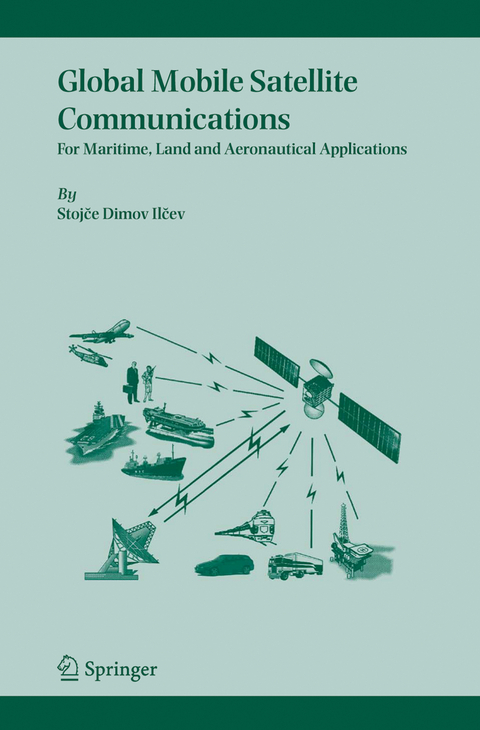
Global Mobile Satellite Communications
Springer-Verlag New York Inc.
978-1-4419-5436-7 (ISBN)
Mobile satellite communications and technology have been in use for over two decades. Its initial application is aimed at the maritime market for commercial and distress applications. In recent years, new developments and initiatives have resulted in land and aeronautical applications and the introduction of new satellite constellations in non-geostationary orbits such as Little and Big LEO configurations and hybrid satellite constellations as Ellipso Borealis and Concordia system. This book is important for modern shipping, truck, train and aeronautical societies because GMSC in the present millennium provides more effective business and trade, with emphasis on safety and commercial communications. Global Mobile Satellite Communications is written to make bridges between potential readers and current GMSC trends, mobile system concepts and network architecture using a simple mode of style with understandable technical information, characteristics, graphicons, illustrations and mathematics equations.
Global Mobile Satellite Communications represents telecommunications technique and technology, which can be useful for all technical staff on vessels at sea and rivers, on all types of land vehicles, on planes, on off shore constructions and for everyone possessing satellite communications handset phones.
Foreword. Reviewer's Foreword. Preface. Acknowlegements. 1: Introduction. 1.1. Abstract. 1.2. Overview. 1.3. Development of Global Mobile Satellite Systems (GMSS). 1.4. GMSC Applications. 1.5. International Coordination Organizations and Regulatory Procedures. 1.6. Satellite Communications Organizations and Operators. 1.7. Frequency Designations and Classification of Services. 2: Space Segment. 2.1. Platforms and Orbital Mechanics. 2.2. Spacecraft Launching and Station-Keeping Techniques. 2.3. Types of Orbits for Mobile and Other Satellite Systems. 2.4. Spacecraft Sub-Systems. 3: Transmission Technique. 3.1. Baseband Signals. 3.2. Analog Transmission. 3.3. Digital Transmission. 3.4. Channel Coding and Decoding. 3.5. Multiple Accesses Technique. 3.6. Mobile Broadband and Internet Protocols. 4: Antenna Systems for Mobile Satellite Applications. 4.1. Evolution of Antenna Systems for Mobile Radiocommunications. 4.2. Antennas Requirements and Technical Characteristics. 4.3. Classification of Mobile Satellite Antennas (MSA). 4.4. Low-Gain Omnidirectional Antennas. 4.5. Medium-Gain Directional Antennas. 4.6. High-Gain Directional Aperture Antennas. 4.7. Antenna Systems for Particular MSC. 4.8. Antenna Mount and Tracking Systems. 5: Propagation and Interference Consideration. 5.1. Radiowave Propagation. 5.2. Propagation Loss in Free Space. 5.3. Atmospheric Effects on Propagation. 5.4. Sky Noise Temperature Contributions. 5.5. Path Depolarization Causes. 5.6. Propagation Effects Important for GMSC. 6: Inmarsat GEO GMSC System. 6.1. Inmarsat System and Structure. 6.2. Inmarsat Space Segment. 6.3. Inmarsat Ground Segment and Networks. 6.4. Inmarsat Mobile Earth Systems (MES). 6.5. Inmarsat Commercial GMSC Service. 6.6. Global Business Solutions. 6.7. Inmarsat Emergency and Safety Service. 7: Cospas-Sarasat LEO and GEO Satellite System. 7.1. Scope of the Cospas-Sarasat System. 7.2. Cospas-Sarasat Mission and Service. 7.3. Overall Cospas-Sarasat System Configuration. 7.4. Cospas-Sarasat Space Segment. 7.5. Cospas-Sarasat Ground Segment. 8: Non-GEO GMSC Systems. 8.1. Big LEO GMSC Systems. 8.2. Global Little LEO GMSC Systems. 9: Global Satellite Augmentation Systems (GSAS). 9.1. Development of Global Navigation Satellite System (GNSS). 9.2. Global Determination Satellite System (GDSS). 9.3. GNSS Applications. 9.4. GSAS EGNOS. 9.5. GSAS MTSAT (MSAS/JMA). 9.6. GSAS WAAS. 10: Global Stratospheric Platform Systems (GSPS). 10.1. Aircraft GSPS. 10.2. Airships GSPS. References. About the Author. Acronyms. Index.
| Zusatzinfo | XXIV, 494 p. |
|---|---|
| Verlagsort | New York, NY |
| Sprache | englisch |
| Maße | 160 x 240 mm |
| Gewicht | 822 g |
| Themenwelt | Technik ► Elektrotechnik / Energietechnik |
| Technik ► Fahrzeugbau / Schiffbau | |
| Technik ► Maschinenbau | |
| Technik ► Nachrichtentechnik | |
| ISBN-10 | 1-4419-5436-8 / 1441954368 |
| ISBN-13 | 978-1-4419-5436-7 / 9781441954367 |
| Zustand | Neuware |
| Haben Sie eine Frage zum Produkt? |
aus dem Bereich


